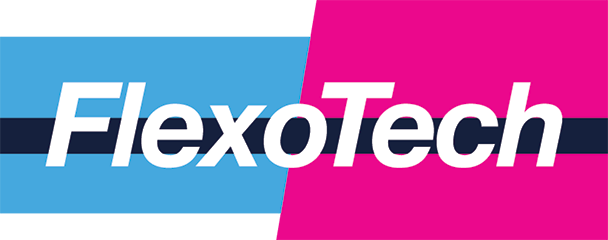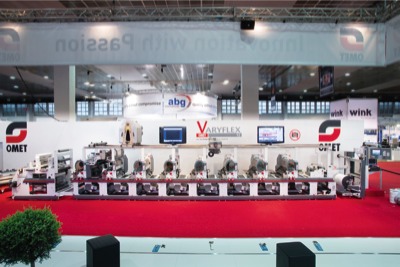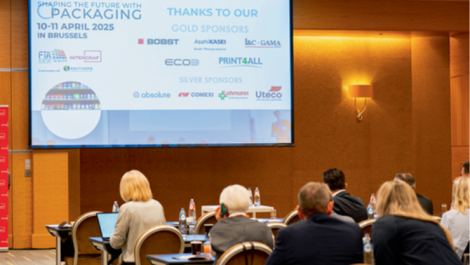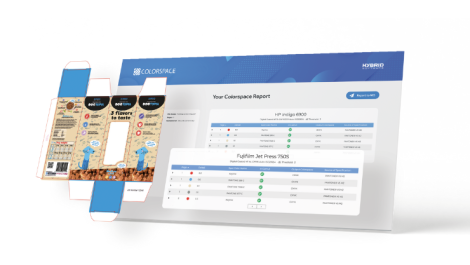Omet’s Varyflex V2
With printing runs in decline, and a demand for more decorative effects, security features and information on the label or package, the definition of combination printing has shifted significantly in recent years. To remain lean and be versatile enough to offer the maximum number of options, interchangeability of process at each station in becoming a standard requirement. By Adrian Tippetts.
With printing runs in decline, and a demand for more decorative effects, security features and information on the label or package, the definition of combination printing has shifted significantly in recent years. To remain lean and be versatile enough to offer the maximum number of options, interchangeability of process at each station in becoming a standard requirement. By Adrian Tippetts.
The need for innovation has been driven by the need to find new ways of appealing to customers at the point of sale. The customer has a split second to choose between competing brands in virtually all retail categories. As formerly cutting-edge effects like clear-on-clear no-label-look have become established on the retail shelf, brand owners are seeking sophisticated alternatives, such as metallic foiling and embossing, enticing the customer to touch and feel the label.
Another factor influencing thedevelopment and design of multi-process printing lines is the increasing need for product information and security features. More stringent European health and safety legislation means more information about ingredients, dosages, hazardous contents must be provided, often in Braille, too. The growth of the counterfeit goods market, facilitated by the Internet, fuels demand for tamper-evident or authentication features such as holograms, optically variable effects with overt or covert colour changing properties.
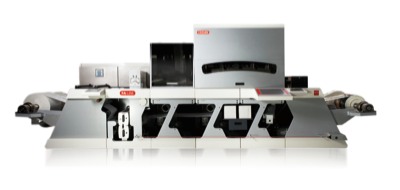 FA-line fitted with Calson digital colour inkjet
FA-line fitted with Calson digital colour inkjet
Heart of innovation
As far as Jakob Landberg, sales and marketing director of Danish press manufacturer Nilpeter, is concerned, the need for more sophisticated ways of appealing to customers in the retail environment has led to the development of quick-change cassette-format printing units, that enable operators to use the best advantages of different processes, anywhere along the printing line, any time. ‘Combination printing is the heart of innovation, focusing on adding value to the label rather than trimming costs. Ten years ago, a combination press would mean a flexo line with a screen or foil unit on top, to achieve a special effect such as a raised image, tactile effect or a metallic finish. Those processes are still in demand, but today combination printing means that every station can be redesigned and adjusted to accommodate different processes. Our vision of combination print is to have a printing line where every station allows interchangeability of processes.’ This enables a much broader spectrum of value-added features. Offset for example, gives more stable parameters so is beneficial for reproducing effects that require a very accurate print on a worldwide scale. One can imagine reproducing the vignette in offset, while using flexo to achieve a bright opaque, with screen for a tactile finish. The printer is able to adapt the machine to each job.
Innovations
Printers today use a wide variety of substrates, thanks to innovations in film. The ability to accommodate a combination of label materials and a lamination stage is crucial in some cases. In chemicals or pharmaceutical labels, extra converting operations may be included to produce booklet labels, which give the brand owner a single product solution for carrying a large amount of information, in several languages. Nilpeter works closely with the customer to build a press suited to the printer’s market situation, through its ‘Next’ concept. Customers succeed either by becoming lean or delivering new products that create value. The company launched its new FA-4* line at Labelexpo Americas 2012. This new 420 mm press features sleeves for fast changeover and includes a short web path, easy loading of tools and the company’s Cleaninking closed ink chamber system, which ensures uniform ink coverage, eliminates spray and prolongs ink life. It also includes Nilpeter Power Link press controls that claim to enable a leaner manufacturing workflow.
Tough market
Swiss press maker Gallus too believes that, in a competitive market, those who specialise, and have the flexibility to offer the widest range of finishes are most likely to thrive. The St. Gallen-based company’s comprehensive technology includes flexo, offset, screen, gravure, hot and cold foil, laminating, multi webs, die-cutting, embossing, slitting and sheeting. The company says its commitment is to ‘Total Cost of Ownership’, and claims that its diverse expertise and machine catalogue allows it to cater for any specific requirement. ‘I can only see the market getting tougher, so it will be those converters who seek out and supply niche markets, such as very high quality printing with special finishes and complex product decoration that will succeed,’ said Wim Brunstig, managing director, Gallus Group UK.Gallus introduced the EM 430 S at Labelexpo 2011. This is an example of a modular design platform that allows flexo and rotary screen to be combined inline. It claims to have a shorter web path in the press and faster response times for register adjustment. It can process any substrate from just a few microns up to 450 microns, enabling conversion of substrates ranging from from foil to card, including aluminium foil and tube laminates. The cooling roller and the UV drying system have been relocated above the top plate in the short web version, halving the web path between printing nips from 4.4 metres to 2.2 metres. The company claims waste values of less than 50 metres as a result, without affecting modularity. The Gallus RCS 330/430 supports six printing processes, including flexo, offset, screen, hot and cold foil which can be interchanged without tools or separating the web. The company reports that 70% of its customers’ jobs are for runs of 100,000 labels or less. It sees set-up cost reduction as of prime concern to press design. Its integral washer cleans the anilox roller so inks can be changed without external washing. Direct drive technology enables changes to text to be made on the job.
Add digital
Many printers are printing on different types of substrate, including flexible packaging, tube, in-mould labels and shrink sleeves, in order to offer a wider range of decorative options and effects. Jakob Landberg says of Nilpeter customers, ‘In the overall market we estimate 30% of label printers probably also print with film, but 80% of our customers buy machines with the ability t oaccommodate both.’ Thanks to rising levels of quality and performance, digital print process is finding a niche in combination with flexo, for short-to-medium label runs. Caslon, a digital colour inkjet press jointly developed between FFEI and Nilpeter, can be installed as part of a traditional narrow web label press or utilised as a standalone digital inkjet system, converting high quality labels up to 420 mm web widths, at 25 m/min rising to 50 m/min (dependent on resolution). Caslon incorporates a new digital spot colour unit printing white ink, and FFEI’s latest RealPro Workflow software. This enables label converters and digital print houses to partner with one technology supplier where all components are designed to work together.
Change the cassette
Despite digital innovations, screen print is still an important feature of the printing line. One of the key suppliers of screen technology is Stork Prints Group (SPG) of Boxmeer, the Netherlands. The company has been working to make the technology more cost effective for users who need the technology for shorter runs or who need an occasional screen effect. SPG offers EasyFit cassette screen units specially designed for a number of press manufacturers. These can be exchanged with other processes, on the same printing station. Ron Wens, manager of project and engineering graphics, said that the screen process is the most effective way of achieving a number of high end effects. ‘If you only produce a flexo varnish, it is possible to achieve the effect with perhaps two flexo stations. But screen still has the edge because it is possible to lay down as much as 300 micron deposits in a single pass. That makes it most effective for tactile finishes that require over 60 micron, Braille, which requires 250 micron dots.’ Rotary screen speeds are application dependent, and range from about 40 m/min for the highest deposits to about 100 m/min for spot varnishes. For mid web presses, from about 900 mm, screen is commonly used for industrial or security applications alongside gravure or offset.
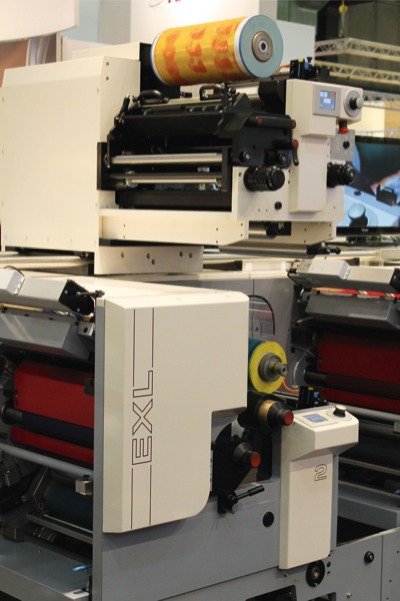 MPS EXL packaging press
MPS EXL packaging press
Variation is needed
Flexibility is a key design feature of narrow web presses. Italian press manufacturer Omet offers the VaryFlex V2 Combination press, which allows flexo (UV, water-based or solvent), gravure, digital, cold foil and rotary units to be added to every position on the press. Built on a platform concept, it enables a host of features including reverse printing, foiling, overprinting, metallising, relief printing and converting in a single pass. It is available in 430, 530, 670 and 850 mm widths and can print on substrates from 12 micron film to 600 micron folding carton. MPS launched the 14 colour EXL offset packaging press at Labelexpo Europe 2011. This has variable sleeves for different repeat lengths, for both plates and blankets, and can be equipped with various flexo, gravure and screen units, in addition to flexo units on rail. Multiple converting units like hot/cold foil, delam/relam, die-cutting and laminating can also be installed. A gravure unit enables the customer to dry solvent-based inks with the use of hot air. Another feature that the offset press offers optionally is the MPS Ultraflex rail system. This innovative positioning and parking system for railmounted units provides the ability to set aside or move the unit to the job location where it is required. The MPS Change Die station enables die-cutting of fine materials and difficult shapes at high speeds, followed by a matrix removal system that shreds and removes the matrix. At full speed, the offset press can run up to 200 m/min.
